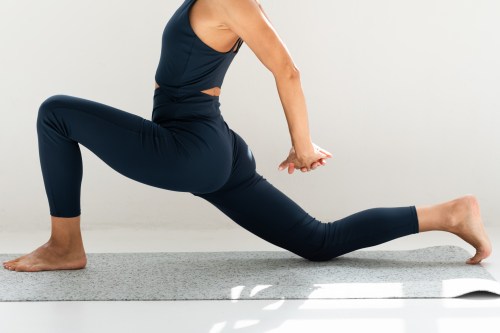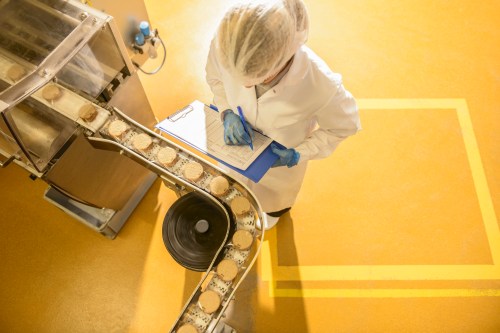When you think about working out to relieve stress, classic “relaxing” routines like yoga or tai chi may come to mind. However, your go-to Pilates routine can also help you reduce stress and anxiety in powerful ways.
Pilates has re-emerged as a popular workout trend in 2024 (interest in floor Pilates, for instance, has grown by 37 percent over the past year, per consumer data company Glimpse)—and there’s good reason why. Not only is Pilates designed to improve your strength and flexibility, but it can promote a mind-body connection that can help reduce stress.
Here’s what to know about the link between Pilates and feeling calmer, plus a 10-minute workout to try at home.
First things first: Why does Pilates relieve stress?
It’s not just anecdotal: Research actually shows that Pilates may help you feel calmer and better overall.
Pilates can help improve symptoms of anxiety through mechanisms like increasing blood and oxygen flow to the brain, relaxing the muscles, and boosting sleep quality, per a 2015 study in Procedia Social and Behavioral Sciences1.
In another 2019 study published in the Journal of Exercise Rehabilitation2, 90 volunteers were randomly divided into three groups—a Pilates group, a yoga group, and a control group (no exercise). The participants in the Pilates and yoga groups did their respective exercises for one hour three times per week over the course of two months.
The researchers found that Pilates was significantly more effective in improving functional movement and individual health level (which includes factors like emotional and mental well-being) than yoga or no exercise at all.
Engaging in physical activity, like Pilates, can help reduce levels of stress hormones like cortisol and increase the production of endorphins, which are natural mood lifters, says Elma Panagaki, RYT-500, a 500-hour certified yoga and Pilates Instructor at Bay Club.
It also helps you control your breath to reduce stress, gets your heart rate up without the need for a high-intensity workout, and helps you better understand the signals your body sends you through heightened awareness, per the Cleveland Clinic.
“Pilates emphasizes the connection between the mind and body through focused movements and controlled breathing techniques,” Panagaki says. “By paying attention to proper form and alignment during exercises, you develop a heightened awareness of your body, which can help you better manage stress and anxiety by staying present in the moment.”
The flowing movements in Pilates sequences, combined with coordinated breathing, can also promote relaxation and a sense of calmness.
“It incorporates stretching and lengthening exercises that help improve flexibility and release muscle tension,” Panagaki says. “Tight muscles are often associated with stress and anxiety, and by promoting flexibility and relaxation, Pilates can help alleviate physical symptoms of stress, such as muscle stiffness and tightness.”
Both Pilates and yoga offer numerous (and similar) benefits for stress relief. However, if you have trouble slowing down, you may find Pilates to be a more active yet equally effective workout for destressing.
“Some individuals are apprehensive about trying to relax, and since yoga is more commonly associated with stress relief, attending a yoga class can seem quite challenging to them,” Panagaki says. “In such cases, Pilates may be a better fit than yoga, since yoga typically involves holding static poses for longer periods.”
A 10-Minute Pilates workout to relieve stress
This short routine created by Panagaki is designed to help relieve stress by promoting relaxation, releasing tension from the body, and fostering a sense of mindfulness and well-being.
“Incorporate it into your daily routine as needed to help manage stress and improve your overall health and vitality,” Panagaki says.
A few tips as you do so:
- Focus on quality of movement, rather than speed, and remember to engage your core throughout each exercise for stability and support.
- Listen to your body and modify exercises as needed to suit your level of flexibility and strength.
- Pay attention to your breath, inhaling deeply through your nose and exhaling fully through your mouth. Let your breath guide your movement and help you stay present in the moment.
If any given move doesn’t feel right to you or causes pain, speak to a trainer to help you with alignment and modifications.
1. Cat-cow stretch

- 1.Start in a tabletop position on your hands and knees, with your wrists aligned under your shoulders and knees under your hips.
- 2.Inhale as you arch your back, lifting your chest and tailbone towards the ceiling (cow pose).
- 3.Exhale as you round your spine, tucking your chin to your chest and drawing your belly button towards your spine (cat pose).
- 4.Flow smoothly between cat and cow poses, coordinating your movement with breath.
- 5.Repeat for 1 minute.
2. Elbow to knee
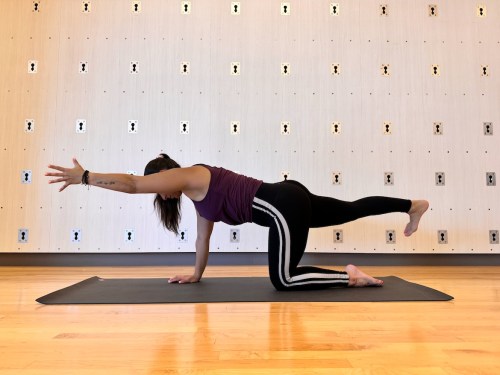
- 1.Start in tabletop position on your hands and knees, with your wrists aligned under your shoulders and knees under your hips. Find a long neutral spine and engage your core.
- 2.Lift your left arm and right leg, parallel to the floor, without relaxing your core. Inhale and lengthen as far as you can reach.
- 3.Exhale and deepen your stomach toward your spine and bring your left elbow to your right knee.
- 4.Repeat 10 reps on each side.
TIP
If you can’t hold your balance, you can keep your arms on the floor and lift only your legs.
3. Seated spinal twist
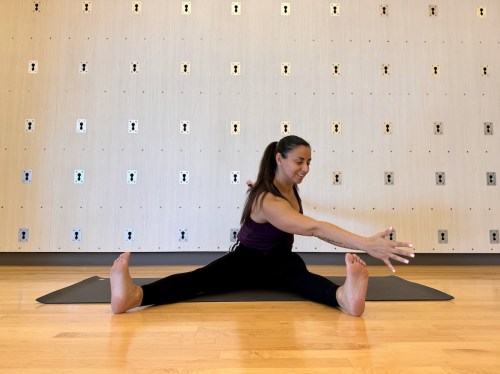
- 1.Sit tall on a mat with your legs extended and spread as wide as you can. Flex your feet.
- 2.Engage your core and open your arms to the side, like a T, with your thumbs facing up.
- 3.Inhale and lengthen your spine.
- 4.Exhale and twist, aiming to reach with your right arm to your left pinky toe, without rounding your back.
- 5.Do 8 reps on each side, alternating sides.
TIP
If it’s difficult to keep a tall spine and your back is rounding, elevate your pelvis by sitting on a pillow.
4. Scissors
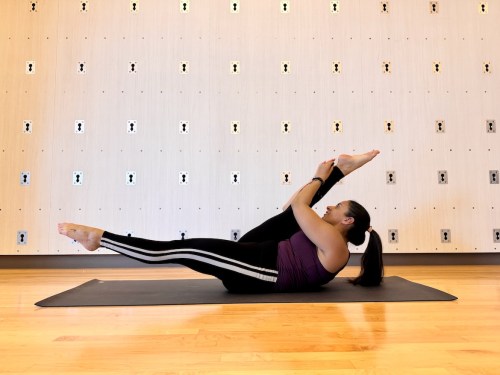
- 1.Lie on your back on a mat with your legs extended straight up toward the ceiling.
- 2.Engage your core muscles by drawing your navel towards your spine and pressing your lower back into the mat.
- 3.Lift your head and shoulders slightly off the mat, keeping your neck long and relaxed.
- 4.Lower one leg toward the mat while keeping the other leg lifted toward the ceiling, maintaining a straight-leg position. Hold the lifted leg with both hands behind the calf, ankle, or thigh, depending on your flexibility.
- 5.Inhale as you switch legs, lifting the lowered leg towards the ceiling while simultaneously lowering the other leg toward the mat.
- 6.Exhale as you switch legs again.
- 7.Continue to alternate legs in a scissor-like motion; repeat for 10 reps.
TIP
If lifting your head feels uncomfortable, you can keep your head on the floor.
5. Bridge
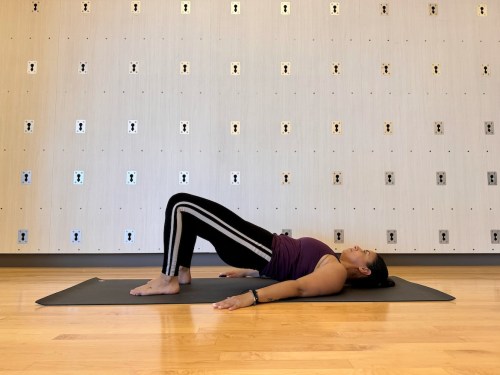
- 1.Lie on your back with your knees bent and feet flat on the mat, hip-width apart. Keep your arms relaxed by your sides with palms facing down.
- 2.Engage your core muscles by gently drawing your navel toward your spine.
- 3.Press through your feet as you exhale and lift your hips off the mat, aiming to create a straight line from your shoulders to your knees.
- 4.Roll your spine up off the mat one vertebra at a time, focusing on articulating through each segment of your spine.
- 5.Inhale at the top of the bridge pose, and exhale as you slowly lower your spine back down to the mat, one vertebra at a time.
- 6.Repeat 10 reps.
6. Child’s pose

- 1.Begin in a kneeling position with your toes together and knees apart.
- 2.Sit back on your heels and lower your chest toward the mat, reaching your arms forward.
- 3.Rest your forehead on the mat and relax your entire body, allowing your breath to deepen and your muscles to release tension.
- 4.Hold the pose for 1 minute, focusing on deep belly breathing and surrendering to any remaining stress or tension.
7. Figure-4 stretch

- 1.Lie on your back. Bend your knees and place your feet flat on the mat, hip-width apart.
- 2.Cross your left ankle over your right thigh, creating a “figure-4” shape with your legs. Flex both feet.
- 3.Keep your head and shoulders relaxed on the mat and continue to breathe deeply and evenly throughout the stretch.
- 4.Hold the stretch for 40 seconds, then release and switch sides, crossing your right ankle over your left thigh.
- 5.Repeat the stretch on the opposite side, again holding for 40 seconds.
8. Supine spinal twist
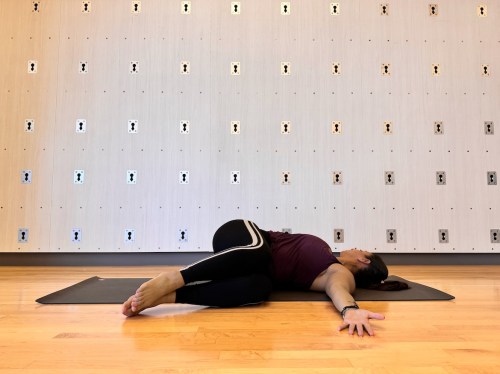
- 1.Lie flat on your back on a mat with your legs extended.
- 2.Bend your knees and bring them toward your chest.
- 3.Open your arms to the side, like a T.
- 4.Send your knees to the left side of your body. Turn your head to look over your right shoulder, feeling a stretch through your spine and outer hip. Keep both shoulders on the floor.
- 5.Hold the stretch for 1 minute, allowing your body to relax into the twist.
- 6.Inhale as you return your knee to center, and exhale to switch sides.
Memmedova, Konul. (2015). Impact of Pilates on Anxiety Attention, Motivation, Cognitive function and Achievement of Students: Structural Modeling. Procedia – Social and Behavioral Sciences. 186. 544-548. 10.1016/j.sbspro.2015.04.009.
↩︎Lim EJ, Park JE. The effects of Pilates and yoga participant’s on engagement in functional movement and individual health level. J Exerc Rehabil. 2019 Aug 28;15(4):553-559. doi: 10.12965/jer.1938280.140. PMID: 31523676; PMCID: PMC6732550.
↩︎
Sign Up for Our Daily Newsletter
Get all the latest in wellness, trends, food, fitness, beauty, and more delivered right to your inbox.
Got it, you've been added to our email list.






